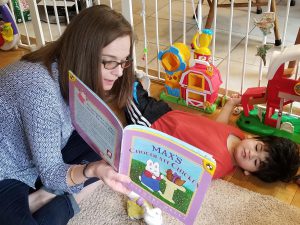 When Joey turned four I reviewed the developmental stages of typical four-year-olds, and was reminded of how much this age group loves physical activity. Gross motor movement is not always easy to incorporate into my work with Joey because we spend so much time with him in his chair reading books and using his AAC device. I made a mental note to remind myself to plan activities that could be done down on the floor with Joey so that I could meet his four-year-old need for physical activity, while also working on some of our other goals.
When Joey turned four I reviewed the developmental stages of typical four-year-olds, and was reminded of how much this age group loves physical activity. Gross motor movement is not always easy to incorporate into my work with Joey because we spend so much time with him in his chair reading books and using his AAC device. I made a mental note to remind myself to plan activities that could be done down on the floor with Joey so that I could meet his four-year-old need for physical activity, while also working on some of our other goals.
Rosemary Well’s book, Max’s Chocolate Chicken, provided a great opportunity to get Joey onto the floor and moving to look for eggs just like Max and Ruby. The simple storyline makes Max’s Chocolate Chicken a fun egg-hunt themed book to use with preschoolers. Max and his sister Ruby are on an egg hunt, and the winner gets a chocolate chicken. Unfortunately for Max, Ruby finds most of the eggs, while he explores the outdoors the way any toddler or preschooler would. Eventually, Max grows tired of Ruby’s taunts and hides away to eat the chocolate chicken, ignoring all the rules of the egg hunt. In true Max and Ruby fashion, it’s a silly story that seems to capture childhood intentions.
 Joey and I read this book on the floor to fully engage in egg hunt fun. I brought out my Max and Ruby dolls so we could act out the story, but I also had eggs with farm stickers inside (Joey loves farm animals) so that we could have our own egg hunt. After acting out the story with the dolls and the eggs, I rolled the eggs around the floor so that Joey could have an egg hunt of his own.
Joey and I read this book on the floor to fully engage in egg hunt fun. I brought out my Max and Ruby dolls so we could act out the story, but I also had eggs with farm stickers inside (Joey loves farm animals) so that we could have our own egg hunt. After acting out the story with the dolls and the eggs, I rolled the eggs around the floor so that Joey could have an egg hunt of his own.
Once I became a parent I began to appreciate the pure beauty of the spring egg hunt. It is a whole-body, integrated activity, that can provide practice for visual-spatial processing, motor planning, receptive language, number sense (counting the eggs) and problem-solving techniques when finding those hard to reach eggs. And it’s so simple. We hide eggs and kids run to find them. We can give them clues about where the eggs are hiding (working on receptive language), and encourage them to develop their problem solving skills in figuring out how to get some of the harder to reach eggs. Collecting and counting the eggs provides great practice with early number sense. It is a shame it becomes such a seasonal activity, because we could do so much with this type of activity all year long.
Our egg hunt for Joey also gave him gross motor, visual-spatial processing and motor planning practice as he navigated his way to the eggs. Joey is an expert at moving around his living room when he is motivated, and it is always unbelievable to watch him move from one side of the room to the other to get something he wants. Although this is not always a straight forward task for him, he puts in the additional level of focus his body requires to coordinate his arms and legs to roll in the right direction. I love being able to watch Joey use his full body to engage in our activities, because you can see just how his mind works to plan getting himself from one place to another.
It is a shame egg hunts are such seasonal activities. I need to find some other open-ended activities that provide us with more opportunities to work on the floor.


